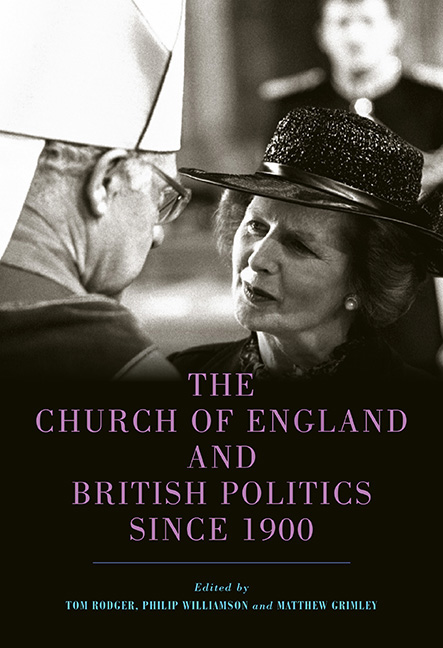Book contents
- Frontmatter
- Contents
- Notes on contributors
- Preface
- Abbreviations and locations of principal collections
- Introduction: the Church of England, the British state and British politics during the twentieth century
- 1 The politics of Church defence: Archbishop Davidson, the national church and the ‘national interest’, c. 1900–14
- 2 Archbishops and the monarchy: leadership in British religion, 1900–2012
- 3 Ecclesiastical conservatism: Hensley Henson and Lord Hugh Cecil on Church, state and nation, c. 1900–40
- 4 Hensley Henson, the prayer book controversy and the conservative case for disestablishment
- 5 Assembling an Anglican view of self-governing sexual citizenship, 1918–45
- 6 Politics in the parish: Joseph Needham at Thaxted, c. 1925–85
- 7 Anglicans, reconstruction and democracy: the Cripps circle, 1939–52
- 8 Parliament and the law of the Church of England, 1943–74
- 9 The Church of England and religious education during the twentieth century 199
- 10 Spiritual authority in a ‘secular age’: the Lords Spiritual, c. 1950–80
- 11 ‘A sort of official duty to reconcile’: Archbishop Fisher, the Church of England and the politics of British decolonization in East and Central Africa
- 12 A ‘baffling task’: Archbishop Fisher and the Suez Crisis
- 13 John Collins, Martin Luther King, Jr, and transnational networks of protest and resistance in the Church of England during the 1960s
- 14 The Church of England, minority religions and the making of communal pluralism
- Index
- STUDIES IN MODERN BRITISH RELIGIOUS HISTORY
4 - Hensley Henson, the prayer book controversy and the conservative case for disestablishment
Published online by Cambridge University Press: 28 April 2020
- Frontmatter
- Contents
- Notes on contributors
- Preface
- Abbreviations and locations of principal collections
- Introduction: the Church of England, the British state and British politics during the twentieth century
- 1 The politics of Church defence: Archbishop Davidson, the national church and the ‘national interest’, c. 1900–14
- 2 Archbishops and the monarchy: leadership in British religion, 1900–2012
- 3 Ecclesiastical conservatism: Hensley Henson and Lord Hugh Cecil on Church, state and nation, c. 1900–40
- 4 Hensley Henson, the prayer book controversy and the conservative case for disestablishment
- 5 Assembling an Anglican view of self-governing sexual citizenship, 1918–45
- 6 Politics in the parish: Joseph Needham at Thaxted, c. 1925–85
- 7 Anglicans, reconstruction and democracy: the Cripps circle, 1939–52
- 8 Parliament and the law of the Church of England, 1943–74
- 9 The Church of England and religious education during the twentieth century 199
- 10 Spiritual authority in a ‘secular age’: the Lords Spiritual, c. 1950–80
- 11 ‘A sort of official duty to reconcile’: Archbishop Fisher, the Church of England and the politics of British decolonization in East and Central Africa
- 12 A ‘baffling task’: Archbishop Fisher and the Suez Crisis
- 13 John Collins, Martin Luther King, Jr, and transnational networks of protest and resistance in the Church of England during the 1960s
- 14 The Church of England, minority religions and the making of communal pluralism
- Index
- STUDIES IN MODERN BRITISH RELIGIOUS HISTORY
Summary
In the winter of 1928, Herbert Hensley Henson, Lord Bishop, delivered his second quadrennial charge to the diocese of Durham. This was no ordinary visitation document. Its 83-page ‘Introduction’ outlined a compelling argument in favour of the disestablishment of the Church of England. That so senior a bishop of the realm should have publicly advocated so subversive a measure was strange in itself. To be sure, many disgruntled clergymen had conceived of suitably drastic solutions in the wake of the parliamentary defeat of the proposed revision of The book of common prayer the previous year. But no comparably significant figure had openly declared the necessity of such a fundamental dislocation in England's ecclesiastical state. Disestablishment had been the great dissenting cause of the nineteenth century. Suddenly, it was espoused by the most articulate prelate on the bench. Moreover, Disestablishment was a report conceived with a vengeance. It called for immediate separation, it envisaged speedy disendowment, it pointed to the desirability of strengthening the ecclesiastical courts, and it insisted upon a thorough reworking of the Church’s administrative machinery. It was cast as a polemic; but it meant business.
No small part of Disestablishment's intellectual force lay in the fact that it did not represent Henson's first statement of his highly unorthodox case. That had been rehearsed in a dramatic sermon, delivered before the bishop of London and the editor of The Tablet, at St Mary's Church in the University of Cambridge, on 29 January 1928. Instead, it described what had by then become Henson's definitive word on the matter. The still greater extent of the political shock waves that this book provoked can be explained only in terms of its author’s personal history. For Henson was not merely a curious convert to this heterodox plan. He was a notorious ‘turncoat’ too. From 1886, Henson had fought with every available weapon at his disposal, whether institutional position, personal connection, crusading pen or even waspish tongue for the continued establishment of the Church of England. After the House of Commons rejected the revised prayer book, first in 1927 and then again in 1928, he devoted all those same endowments to a pursuit of the opposite end.
- Type
- Chapter
- Information
- The Church of England and British Politics since 1900 , pp. 102 - 119Publisher: Boydell & BrewerPrint publication year: 2020
- 1
- Cited by



